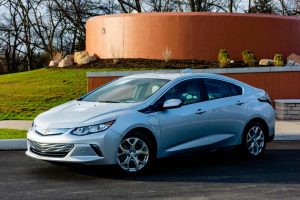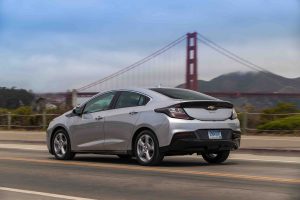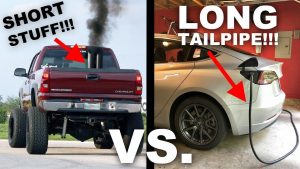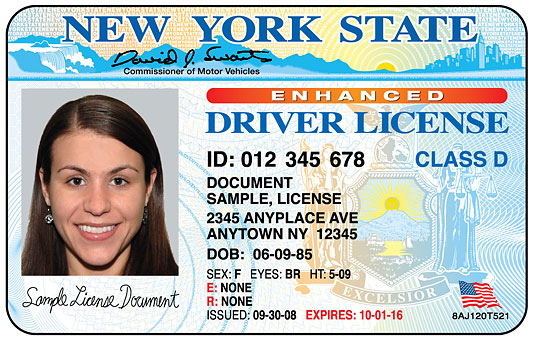You may have noticed an interesting thing – which is that hybrids are, like MacArthur, slowly fading away. You don’t see them advertised as much – and they’’re not being built as much. Only a few new hybrids have come out over the past couple of years and it looks like fewer are coming. The 2021 Honda Accord and Toyota Camry are not available in hybrid configuration.
They were in 2020.
Toyota stopped selling the Prius C – the most affordable hybrid on the market – in 2019. The same year Chevy stopped selling the best hybrid ever offered for sale, which was the Volt.
This is odd – if one assumes the point is to reduce “emissions” and increase MPGs. Hybrids excel at both.
They solve the supposed problem.
Their partially running gas-burning engines automatically “emit” half or less the putatively harmful stuff at issue because they aren’t running half the time. And they weren’t “emitting” much to start with – because a hybrid’s engine is a smaller engine than would otherwise be needed to propel the car, the battery and electric motor doing much of the heavy lifting.
The typical hybrid’s mileage, meanwhile, is nearly double that of the current non-hybrid average – in the 50s vs. the 30s.
Lots of gas is being saved. And a lot less gas is being “emitted.” Problem solved!
The problem, of course, is just that. Hybrids solve the supposed problem – and they do so without limiting mobility and worst of all, affordably.
And that’s the point – or rather, the real problem.
A Prius C cost just over $21k brand new and for that you got a car that could travel more than 400 miles on 9 gallons of gas that didn’t need to stop for more than about 5 minutes in order to be ready to travel another 400 miles.
Contrast that with a Nissan Leaf electric car that costs $31,000 new – and goes 150 miles before you have to stop and wait at least 30-45 minutes before you can go another 150 miles.
A Chevy Volt could travel 1,000 miles- or even more – without burning any gas at all. It was capable of driving 50 miles on a charge – which meant that so long as you didn’t exceed its range on the batteries, the gas engine never came on at all. Many owners reported going months without refilling, necessitating fuel stabilizer to keep the gas in the tank from going bad. 
And if you exceeded the car’s electric-side range, you didn’t have to stop. The gas engine kicked on and you kept on going, stopping (if you needed to) only long enough to put a few gallons into the tank.
You could recharge whenever it was convenient.
Perfect!
But this created a problem which hybrids were never meant to solve. It was hoped that ever-tightening fuel efficiency and emissions standards would make it functionally or economically impossible to continue selling – or buying – cars at all. If this sounds conspiratorial or a bit much, consider what’s going on right now with regard to the use of manufactured fear of a virus as cover for the implementation of a “new normal” that has been advocated by leftist extremists under the guise of environmentalism for a generations.
Part of this “new normal” includes restricting people’s mobility.
If that weren’t the true goal, then hybrids rather than electric cars would be welcomed as the godsend they are. Because they are a perfect example of having your cake (no negative effect on mobility at a price most people can afford) and eating it, too (high gas mileage, almost nil in the way of harmful emissions).
The emissions thing is especially telling vis-a-vis those of the electric car, which are higher because the EVs being sold are focused on performance rather than efficiency, a disconcerting (or so it should be) fact this column has pointed out on a number of prior occasions.
EVs have unnecessarily huge – and so, unnecessarily expensive – battery packs that require far more electricity than is necessary to charge them . . . if the car were designed to be efficient (or affordable) transportation.
This results in the creation of more of the gasses (carbon dioxide) which is the opposite of thing supposedly wanted but which does achieve the things actually intended, i.e., reducing people’s ability to get around – mobility – by making it too expensive for most of them to get around and by limiting how far you can get around even if you can afford the things.
Hybrids were, in brief, too good for their own good.
And ours.
. . .
Got a question about cars, Libertarian politics – or anything else? Click on the “ask Eric” link and send ’em in!
If you like what you’ve found here please consider supporting EPautos.
We depend on you to keep the wheels turning!
Our donate button is here.
If you prefer not to use PayPal, our mailing address is:
EPautos
721 Hummingbird Lane SE
Copper Hill, VA 24079
PS: Get an EPautos magnet or sticker or coaster in return for a $20 or more one-time donation or a $10 or more monthly recurring donation. (Please be sure to tell us you want a magnet or sticker or coaster – and also, provide an address, so we know where to mail the thing!)
If you’d like an ear tag – custom made! – just ask and it will be delivered.
My latest eBook is also available for your favorite price – free! Click here. If that fails, email me at [email protected] and I will send you a copy directly!












I was really surprised and angry when I heard GM plans on making no more hybrids, only EVs. If they really wanted to save gas they’d be making them until the magical day when EVs are ready to take over. Some use cases will never make sense as EVs (like semis). Why don’t we switch everything over to PHEV or that new “mild hybrid” 48v system? Now that’s have your (V8) cake and eating it too.
Hi Anon,
Hybrids aren’t “zero emissions” -just almost – and that’s not quite good enough. Even though EVs aren’t “zero emissions,” either. But they get a pass because their emissions are sourced remotely – even though they are considerable. And because of politics. Because it’s not really about emissions. It is about getting most people out of cars, period.
One thing that soured people on Hybrids (and will on EVs, as soon as ordinary people can afford them) is that while the battery is covered by the factory warranty (typically 3 years or 36k miles), if you have to get one replaced while under warranty you will no longer get the remainder of that bumper-to-bumper warranty – you will get the parts warranty.
“The 2021 Honda Accord and Toyota Camry are not available in hybrid configuration.”
?
I still see multiple hybrid Camry trims for 2021 model year posted on Toyota dealer websites as of summer 2020.
RAV4 hybrid gets better reviews than the gasser.
Sienna is hybrid-only for 2021.
I wish I could say that the interference in market forces is a result of ignorance. It’s not. We have an over abundance of evidence and experience demonstrating that such actions are not only ineffective, but destructive. We’ve been here before. It is instead a demonstration of insanity. Even for those who expect to come out on top in the tyrannical end, the results will not be positive. Top down management results in less wealth creation. Always. Since the state produces nothing, the only way it can influence the market place is by inhibiting production. Which means less wealth production. Which means less for EVERYBODY. Including the self proclaimed masters. It’s a suicidal exercise, and I suspect a considerable amount of mental disorder is the cause. There is little to promote sanity involved in government. The psychotic tend to prevail. Once one realizes that it’s not just greed or immorality that drives tyranny, but mental defect, things become a lot more clear. No sane person has any desire to hold a gun to their neighbor’s head and force them to do, or not do, anything except to prevent their neighbor from doing so to them. Such is not normal human behavior.
You nailed it EP. Limiting freedom in all its forms is what it’s all about.
Even my “liberal” dad, who was excited about California banning IC engines hadn’t even THOUGHT OF the fact that they still need to burn fossil fuels to charge them when I asked what fuel is used to provide the electricity for their charge… “oh yeah”… he said. But then no further thinking, just berrrrrrrp, back into the borg.
EVs are expected to get cheaper than Hybrids.
I drive a Chevy Volt and while it’s a fabulous car by almost every measure, the Product Designers think
that EVs will have fewer moving parts and be cheaper to sell in a few years. So they are planning for that future.
Clover,
EVs are “expected to get cheaper” – but they aren’t and I doubt they ever will be, absent a revolutionary change in battery/charging technology and even if they did, they’d still cost more – in terms of time and convenience.
Your Volt is the apotheosis of hybrid design. It was abandoned because of expense but also because it doesn’t satisfy the cultic obsession with “zero” emissions – which aren’t even that, unless you can figure out a way to generate electricity without creating emissions and the vehicle’s manufacture does not produce more emissions than would be emitted by a highly efficient IC or hybrid IC car.
The false image of EV as zero emissions is due to out of sight, out of mind. Electricity just comes in on wires, right? Just like hamburger just comes from the grocery.
Exactly so, Sparky.
The EV is marketed as “clean” – but most people have no clue what “clean” means. I encounter this all the time. The average person believes a 2020 IC car is dirty – having been outright lied to about this by the propaganda organs, which refuse to either define exactly what comes out of a car’s exhaust pipe and how much – i.e., to put it in context. It’s of a piece with the cases! the cases!
They say you can’t cheat an honest man. But you sure can fool a stupid one.
“EVs are “expected to get cheaper” – but they aren’t ”
The Tesla Model S started at at an MSRP of 80K , and was 112K loaded.
Now it’s $69K and loaded about 83K maybe 90K if you trust the autopilot.
Decent enough price improvement especially when you consider the technology improvements over 8 years.
The Model 3 is a smaller model then the Model S but it’s MSRP at high 30’s low 40s.
Tesla is working their way down towards affordable EVs.
Certainly the green eye-shade crowd is buying that.
Clover,
If you think $69,000 (or $40,000) is “affordable,” you make my point. Do you know what the average family income is? The $30,000 Nissan Leaf is too expensive for the average American – which is why Nissan has been forced to massively discount them just to get rid of them. There is an inherently limited market for $30,000 “economy” cars and a 40,000 economy car is even more absurd. EVs are boutique cars – indulgences for the affluent. For them to ever be viable as mass-market cars, the price – the real price, not subsidized – would need to come down by about half and even then, they would still cost too much – regardless of price – because of what they cost in time-wastage and hassle.
Here is the game plan courtesy of Norway, which has the highest share of PEVs (plug-in electric vehicles):
Since 1990, the Norwegian parliament has taken aggressive steps to reduce its greenhouse gas emissions by enacting a suite of pro-EV policies.
The policies are generally aimed at making PEVs less expensive than ICE vehicles. They have been successful in large part because of the high cost of car ownership in Norway.
In addition to the purchase price and sales tax, an ICE vehicle owner in Norway must also pay annual value-added taxes based on the vehicle’s emissions—up to 29 percent of total vehicle cost; road and ferry tolls; registration taxes; and $881 per month on gasoline on average, the highest rate in Europe.
Now that incentives have largely made PEVs self-sustaining, parliament plans to PHASE OUT OR REPLACE THE INCENTIVES.
https://www.americanprogress.org/issues/green/reports/2018/06/07/451722/plug-electric-vehicle-policy/
————
Cute, huh? First Big Gov puts a heavy thumb on the scale to tilt the entire playing field. Then, after the maliciously skewed “market” adjusts to a new, artificially-imposed equilibrium, yank the subsidies and LET THE PEOPLE PAY … AND PAY … AND PAY … with no fallback alternatives.
In the Dark Ages, most peasants never traveled more than a dozen miles from their place of birth during their entire lives. Our neofeudal liege lords can barely contain their euphoria as the unfolding new Dark Age renders them all-powerful over cringeing, immobile serfs.
Hybrids solve actual market problems and artificial ones imposed by EPA. A classical free market solution which in a real way improved people’s lives. They are boring, though. I’d have very seriously considered a hybrid Tacoma had Toyota ever produced one. The lack of government and media push dooms them. It’s not practical to produce Tesla ridiculous performance in the first place and without deep subsidies behind hybrids the manufacturers had to sell vehicles that people actually wanted to buy, thus realistic performance and prices at a sustainable profit. I think it’s not a stretch to say that if the car market was *truly* free and competitive we’d most of us be driving hybrids by now. It’s a perfectly elegant transition from a well established technology (thus affordable from decades of infrastructure development) to new technology that can mature in parallel without relying solely upon it.
The disappearance of hybrids makes sense-if one looks at the REAL, unstated motive…
It’s not about getting us out of “dirty” cars and into “clean” cars; it’s about getting us out of cars, period.
Uh, that was my POINT…